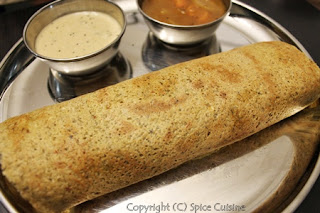Back to the recipe, soybean is a type of legume that originates from East Asia and is used in making either non-fermented or fermented food. Some of the non-fermented foods include soy milk and tofu whereas fermented foods are used for soy sauce, tempeh, etc.,
Soybean is known for its significant levels of essential amino acids that is vital to human body and is considered a good source of protein, especially for vegans and vegetarians. Immature soybeans that are still in their green pods are popularly known as 'edamame' which is finding its way in salads, hummus, etc., these days. In most asian cuisine, soybean is more of a staple in some form or the other. In Indian cooking, dry soybean is not used much although it is slowly gaining popularity. Soybean is similar to any other bean variety and it can be easily replaced with any legume of your choice.
Poppy seeds are considered to be highly nutritious and white poppy seeds are added to give thickness and flavor to any dish. Poppy seeds are hard to grind, so a dry grind followed by wet grind (adding water) gives the desired paste consistency. This simple recipe is a good accompaniment for rotis or rice.
Ingredients:
1 1/2 cups dry soybean, soaked overnight and boiled
1 1/2 tbsp oil
1 medium onion, finely chopped
1 tsp cumin seeds
1 heaped tsp ginger-garlic paste
2 medium tomatoes, finely chopped
1/4 tsp turmeric powder
3/4 tsp red chilli powder
1 1/2 tsp coriander powder
1 1/2 tsp poppy seeds
2-3 tbsp grated coconut, fresh or frozen
8-10 cashewnuts
1 - 1 1/2 cups filtered water
1/4 cup fresh cilantro, finely chopped
Lemon juice, to taste
Salt, to taste
Method:
Soak the dry soybean in water overnight. Toss out some of the outer shell that remains in the water and rinse again.
Pressure cook the soybeans with enough water for about 5-6 whistles (if you are cooking in a pan, cook until the soybeans is slightly soft which could take up to 20-25 mins or so).
Add ginger-garlic paste and sauté until the raw smell is gone. Add the chopped tomatoes and cook until slightly pulpy.
Add turmeric powder, red chilli powder, coriander powder and salt. Cook for few minutes until the flavors blend well. Add 1 - 1 1/4 cups water and salt, if required, and allow it to boil.
In a blender, dry grind the poppy seeds until they become a fine powder. Add a little water and grind to a paste. Now, add the grated coconut and cashewnuts and grind finely.
Add the ground paste and mix well. Cook for 5-6 mins until the gravy starts boiling.
Add the chopped cilantro and lemon juice (adjust to taste). Stir well and serve hot with rotis or rice.
Makes 3-4 servings.





























